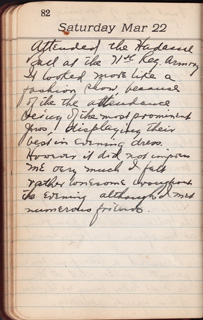
The day was dull as usual,
and in the evening I was rather
busy, I attended two balls,
The first one was the Zionist Ball
at Webster Hall, by the Tikvath
Yehuda Club, the 2nd the
Jewish Authors Ball, at 71st Reg.
Armory, I enjoyed both as
I met numerous friends, I
had only one dance at each and
of course walzes My favorite.
As usual I wore my tuxedo,
The many girls I saw were
really beautiful very beautiful
but none of them appealed to me,
Jazz-babies, wild women, and
none of that good type which
appeals to me and so rare among
women.
—————-
Matt’s Notes
Since I’ve started this blog I’ve thought a lot about what I do and don’t share with my grandfather. This entry’s got a few easy ones: I’ve seen the inside of Webster Hall (which is still at its original 11th Street location) but not the long-demolished 71st Regiment Armory (though a piece of it adorns the subway stop under its former location). I own a tuxedo, but I can’t waltz. I can’t imagine that I’d ever find the women at something called The Jewish Authors’ ball to be too “wild”, but I didn’t grow up in the old country.
A more challenging thing to think about is how the Jewish orientation of his social and spiritual life did not find its way to me. Though I rocked a brown Pierre Cardin three-piecer at my Bar Mitvah, I had decided long before that I was an atheist (I’m Jewish, all right, but God just doesn’t compute). I’ve known a few more religious Jews who, like my grandfather, spent their weekends going around to Jewish events and kept their social lives within sometimes large but always well-established Jewish circles; the parameters appealed to me in the abstract but I couldn’t imagine myself inside them. If know if I were single I’d never use jdate.com, though I get giddy over their “why is this site different from all other sites” billboard (this may sum up where my head’s at more than anything). Then again, while I never went out looking for nice Jewish girls when I was single, I wound up marrying one and I’m very glad to have her. In fact, she’s probably exactly the kind of woman Papa would have liked — pretty, but a “good type” as well.
Hmmm. I’m not sure where I’m going with this and it’s time to wrap up this post (I write these in the morning before work and revisit them at the end of the day, in case you’re wondering) but in reading over the above paragraph I realize I’m triangulating to find whatever kernel of my Papa still survives in me. I get the feeling it won’t be the last time.
Update 1/14
Here’s a photo of my grandfather in the tuxedo he mentions above (at least I assume so; this photo is signed and dated 1919 and I imagine he didn’t get another tuxedo in the intervening five years).



Interestingly, this photo is printed on a postcard, and it’s not the only postcard we have featuring a studio shot of my grandfather. I’ll have to learn more, but I assume it was typical to have these kinds of postcards made up as calling cards. This particular card was made, according to the raised stamp, at photo studio “L. Borressoff, 365 Grand St, N.Y.”
The note on the on the front reads “Sincerely yours Harry Scheurman New York July 1919.” I think it was Papa’s favorite shot of himself, too, because in 1925 he wrote a note on the back and sent it to a woman he was courting named Jean. That was my grandmother. This card came from a box of her memorabilia.

Update 1/17
“Cabinet cards” like the one above were indeed common back then. Descended from smaller cartes de visite (visiting cards) popularized by military officers in the early 1800’s, they had evolved into the larger style pictured here by the 1860’s.
For more, check out Wikipedia’s carte-de-visite entry and City Gallery’s Cabinet Card entry. (Thanks to Durya at the Lower East Side Tenement Museum for the pointers.)


